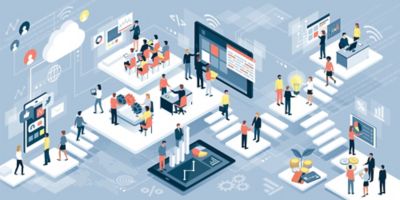-
United States -
United Kingdom -
India -
France -
Deutschland -
Italia -
日本 -
대한민국 -
中国 -
台灣
-
Ansys si impegna a fare in modo che gli studenti di oggi abbiano successo, fornendogli il software gratuito di simulazione ingegneristica.
-
Ansys si impegna a fare in modo che gli studenti di oggi abbiano successo, fornendogli il software gratuito di simulazione ingegneristica.
-
Ansys si impegna a fare in modo che gli studenti di oggi abbiano successo, fornendogli il software gratuito di simulazione ingegneristica.
-
Contattaci -
Opportunità di lavoro -
Studenti e Accademici -
Per Stati Uniti e Canada
+1 844.462.6797
ANSYS BLOG
August 13, 2019
What Is Business Innovation and How Can Simulation Foster It?
Companies need to understand business innovation to grow and succeed.
A common mistake companies make is to improperly invest, grow and seed innovation projects.
The truth is, there are different types of innovations, each with its own costs, risks and benefits. Without a proper plan tailored to each type, research and development (R&D) budgets can go to waste with minimal benefits to the corporation.
In celebration of Ansys making it onto Fast Company‘s Best Workplaces for Innovators list, here are some tips and tricks to define, invest and seed innovation within your company.
Companies need to understand how to innovate to survive.
What Is Innovation in Business?
First, let’s get one thing straight — invention does not equal innovation.
When you invent something, you bring something new and unique into the world. Innovation involves making something unique that creates value. Your innovation can be in the form of a new product, solution or process, but it has to create value for someone. Inventions aren’t always valuable. For an invention to become an innovation, people have to care about it. If your invention doesn’t have an audience, then it isn’t worth pursuing from a business standpoint.
What’s the difference between innovation vs invention? Something needs to have a benefit and value to be an innovation.
Generally speaking, McKinsey & Company has defined three different types of innovations. They are:
- Horizon 1: an improvement or added feature to an existing product
- Horizon 2: an adjacency improvement — when a product becomes useful to a new market
- Horizon 3: a discovery, new product or step change above the competition
How to Invest in Business Innovation
Horizon 1 innovations are short-term, deterministic, low-risk and almost always fit a known customer need. You may learn about this innovation opportunity when customers request a new feature, or your developers discover a quick product improvement.
Invest around 70% of an R&D budget into horizon 1 innovations, 20% into horizon 2 innovations and 10% into horizon 3 innovations.
Developers then need to estimate the time and budget needed to make the horizon 1 innovation. The sales team can help to predict the return on investment (ROI) that this feature will bring based on customer feedback.
Therefore, horizon 1 innovations are fast, predictable, dependable, profitable and almost always successful to implement. Spending a good 70% of an R&D budget on these types of innovations is a good rule-of-thumb.
However, companies that focus solely on horizon 1 innovations are only thinking about the short term. This leaves them at risk of becoming stagnant or displaced over time. That being said, if the core market for a company is growing very fast, it may make sense for the company to focus 100% on horizon 1 innovation. On the other hand, if the core market is flat, or growing slowly, then it also makes sense for a company to invest in horizon 2 or horizon 3 innovation.
Horizon 2 innovations have a lower success rate than horizon 1 innovations. However, their benefits are vast as they can open your company up to brand new markets. Due to the upside potential, spending 20% of an R&D budget on horizon 2 innovations is considered a best practice.
Horizon 3 innovations have the highest risk and the largest reward potential. Horizon 3 innovations can make your organization the first to market or the leader in a market. However, due to their low success rates, 10% of an R&D budget should be dedicated to new horizon 3 concepts.
How to Foster Business Innovation
The two best ways to foster business innovations are to:
- Not put your eggs in one basket
- Never punish failure
The first is self-explanatory. Since innovations have risks — even a horizon 1 innovation can theoretically fail — always have a series of teams working on a variety of potential innovations.
Follow the one pizza rule when organizing your teams — keep them to about three to four people. As teams start to create minimal viable products, working prototypes and testable ideas, then re-evaluate if these concepts warrant more funding, people and freedom.
As teams grow, they should eventually resemble a mini company — complete with developers, marketers and salespeople. This is an important step that is usually skipped. Often, companies develop a new product and instruct the sales and marketing teams to push it. However, these teams may not understand what the new product is or how to best sell it. By having marketing and salespeople involved during a product’s incubation period, they can better teach others how to position and sell the product when it’s ready for market.
In fact, when a company invests in horizon 3 innovation and disruptive new products, it is important to ringfence the developers, marketers and salespeople as a separate organization from the rest of the company. This enables the team to focus all their energies on pursuing the market for this new product or solution.
Finally, these teams should have no fear of failure. Otherwise, every R&D team will flock to the horizon 1 assignments. If this happens, your company will only be focusing on short-term innovations, leading to possible stagnation. It’s inevitable that projects will need to be shut down. When this happens, learn from the failure. Then, the team should be congratulated on its hard work and assigned to other, more promising projects.
Companies need to understand how to innovate to survive.
Open Sources of Business Innovations
The term “Open Innovation” was coined by Prof. Henry Cheseborough from UC Berkeley — it recognizes that ideas can come from a variety of sources — both inside and outside your organization. Keep your eyes, ears and budgets open to innovations that need your company’s funding.
Startups, universities, competitors, companies and governments can all be great sources of innovation.
Look into ways for how to help fund, partner or even acquire, these organizations, if it’s viable.
Remember, acquisitions are a source of innovation. In fact, acquiring a company can be a fast way to attain a low-risk horizon 2 or horizon 3 innovation on a shorter timeframe. However, this speed and reduced risk can come at a high acquisition cost.
Finally, there is nothing that says that innovation has to come from a person or organization. Nature has been continuously innovating itself for billions of years. As a result, biomimicry, the process of studying nature to reproduce processes that could have value, is a great example of open innovation.
Business innovations can come from outside of your organization — even from nature itself.
Simulation Based Business Innovation for a Digital World
Digital technologies like the cloud, internet of things (IoT), artificial intelligence (AI) and machine learning (ML) are changing how companies do business.
Traditionally, engineers would design a product using computer-aided design (CAD) and then use simulations and prototypes to validate it. This development cycle could take years to develop a new product.
With current technologies, engineers can use generative design tools (like topology optimization and parameterization studies) to optimize products early in the development cycle, speeding up their time to market. These generative design technologies are improved by the increased processing power engineers can access within the cloud and graphical processing units (GPU). In fact, Ansys Discovery Live can help engineers gain instant insights into their designs during the ideation phase, promoting rapid product innovations.
Welcome to ANSYS Discovery Live
Ansys Discovery Live is the first ever simulation environment that provides real-time answers to engineering challenges. It lets you interactively change geometry, physics inputs, and results display all while instantly visualizing design performance.
Welcome to Ansys Discovery Live
Digital transformations have also enabled engineers to expand their digital prototyping into the realm of multiphysics. Traditionally, simulations would model a specific physics — such as a product’s strength, aerodynamics or electromagnetic interactions. Today, these simulations can be merged into one fluid-structure-electromagnetic simulation using Ansys multiphysics technology. This enables engineers to make more informed decisions earlier in a product’s development.
Once these multiphysics simulations are built, they can be simplified into 1D systems simulations and integrated into a digital twin using Ansys Twin Builder. Engineers can then link the digital twin to the IoT so they can monitor how customers are using their products. This helps engineers innovate designs and improve their customer’s maintenance cycles using AI/ML and predictive analytics.
By using simulation, your organization might one day find itself alongside Ansys in Fast Company‘s Best Workplaces for Innovators list. To test out how simulation can breed innovation, click here to gain access to a trial of Ansys Discovery Live.














